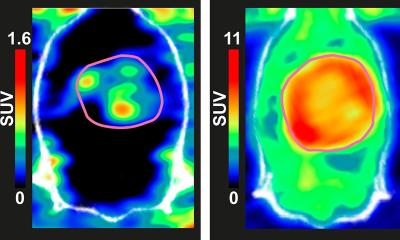News • PET compound
New radiotracer lights up aggressive cancer tumours
Researchers have used a chemical compound to light up treatment-resistant cancers on imaging scans, in a breakthrough that could help medical professionals better target and treat cancer.

Image source: Greenwood HE, Barber AR, Edwards RS et al., Nature Communications 2024 (CC BY 4.0)
The authors at King’s say that using the radiotracer – an injected compound used in PET scans – could help inform doctors that a patients aggressive cancer will not respond to chemotherapy before treatment is given. This would prevent the patients receiving unnecessary treatment and provide them with alternative options that will give them the best chance of beating the disease.
The paper, published in Nature Communications, shows therapy-resistant non-small cell lung cancer tumours’ lit up like a Christmas tree’ on PET scans when the radiotracer was injected. Tim Witney, a Professor of Molecular Imaging from King’s College London, and lead researcher of the study said: “Currently, there is no quick and early method that shows whether malignant tumours are resistant to treatment. Time is essential for patients with lung cancer, and many cannot afford to wait to see if chemotherapy is working. We wanted to increase the window of opportunity for treatment for these patients – giving them more choice and a better chance of survival.”
Non-small cell lung cancer is the most common type of lung cancer in the UK and 47,000 people are diagnosed with it every year. Standard care includes surgery, radiotherapy, chemotherapy and immunotherapy, but despite advancements in treatment, survival rates have not improved much in the past decade. Typically, patients with lung cancer will be started on a treatment plan – such as chemotherapy – and then wait twelve weeks to have a CT or PET scan to see whether the treatment has shrunk the tumour, or the tumour has stayed the same or has grown. But twelve weeks can often be too late to change course of treatment and end-of-life care is frequently the only option.
The radiotracer ¹⁸F-FSPG binds to the tumour-resistant cells and lights up like a Christmas tree in imaging – clearly showing the aggressive cancer
Tim Witney
Researchers from King’s re-purposed a radiotracer, currently used as a diagnostic tool in clincal trials in the USA and South Korea, to show treatment-resistant tumours on PET scans. The molecule targets xCT, a tumour-associated protein which is present on therapy-resistant tumours. In images from the study, PET scans of animal models show tumour-resistant cancer cells light up brighter compared to tumours responsive to treatment. The authors will now trial this in humans with a phase I clinical trial beginning in January at St Thomas’ Hospital in London. The trial will recruit 35 patients and use the total-body PET scanner at the hospital’s PET Centre to see xCT with imaging before and after patients receive treatment.
Professor Witney added: “Our study is the cumulation of five years of work. Frequently, cancer patients find out too late that the treatment they’re on does not work. The radiotracer 18F-FSPG binds to the tumour-resistant cells and lights up like a Christmas tree in imaging – clearly showing the aggressive cancer. With this technique, we can give the right treatment to the right patient, making it more cost-efficient for the NHS and providing hope for patients with aggressive tumours.”
In the same paper, researchers also show that xCT can also be targeted by an antibody-drug conjugate, a new class of drug designed as a targeted treatment for therapy-resistant cancer cells, which selectively kills these cells whilst minimising unwanted toxicity. While research is still in the early stages, the authors hope this could offer a glimmer of hope for patients with the most aggressive and difficult-to-treat cancers, including lung, pancreatic and breast cancers.
The study was funded through a Wellcome Trust Senior Research Fellowship and by UKRI under the UK government’s Horizon Europe funding guarantee.
Source: King's College London
19.12.2024











